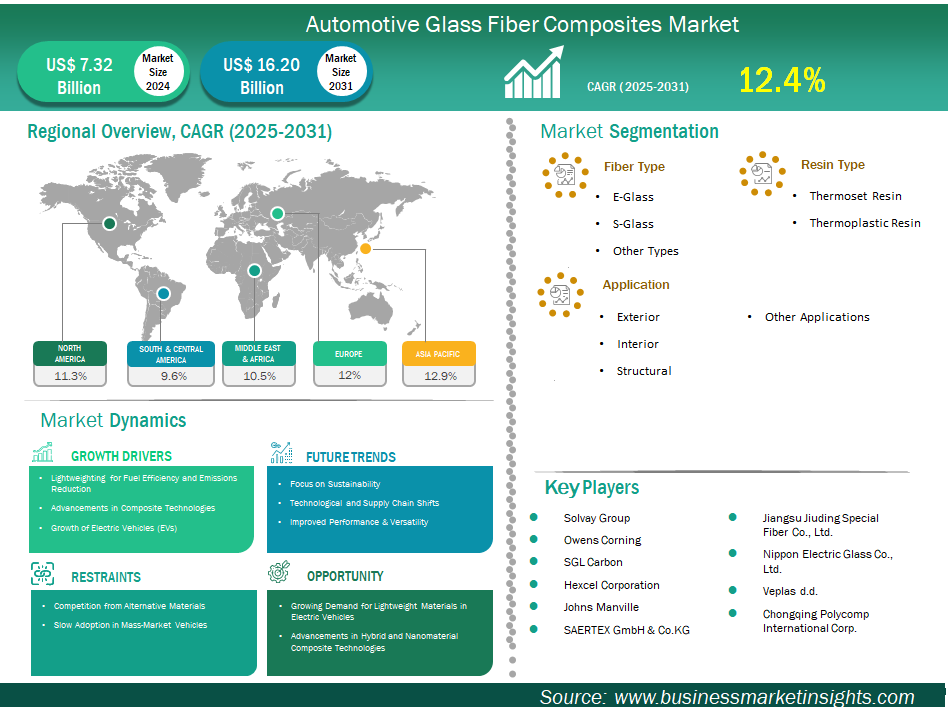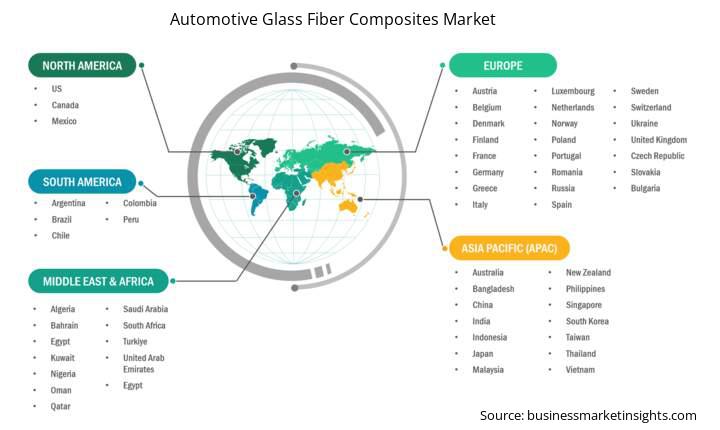Automotive Glass Fiber Composites Market Outlook (2021-2031)
No. of Pages: 200 | Report Code: BMIPUB00031713 | Category: Chemicals and Materials
No. of Pages: 200 | Report Code: BMIPUB00031713 | Category: Chemicals and Materials
The automotive glass fiber composites market size is expected to reach US$ 16.20 billion by 2031 from US$ 7.32 billion in 2024. The market is estimated to record a CAGR of 12.4% from 2025 to 2031.
This report provides a comprehensive analysis of the global automotive glass fiber composite market, thoroughly assessing its size, market share, and key dynamics for the 2021–2031 forecast period. It is structured to equip stakeholders with a strategic perspective on the market, detailing major growth drivers, challenges, opportunities, and the competitive landscape. The study employs a rigorous research methodology, integrating both primary and secondary data sources, to deliver a clear and actionable overview of the market’s projected development and trends.
The global automotive glass fiber composites market is experiencing steady growth, driven by the automotive industry’s push for lightweight, high-strength materials to enhance vehicle performance, fuel efficiency, and sustainability.
Key growth drivers include the need to meet stringent emissions regulations, improve fuel economy, and support the expanding electric vehicle (EV) market. Glass fiber composites are increasingly used in automotive exteriors (body panels, bumpers, fenders), interiors, and structural components due to their excellent strength-to-weight ratio, corrosion resistance, and design flexibility. Advancements in manufacturing technologies, such as automated fiber placement and resin transfer molding, are making these materials more accessible and cost-effective for automakers.
The rise of hybrid composites—combining glass fibers with carbon fibers or thermoplastics—offers further opportunities, providing enhanced mechanical properties and enabling manufacturers to meet evolving performance requirements for both conventional and electric vehicles

Key segments that contributed to the derivation of the automotive glass fiber composites market analysis are fiber type, Resin type, application, and geography.
Increasingly stringent global fuel economy and emissions regulations compel automakers to reduce vehicle weight. Glass fiber composites offer an excellent strength-to-weight ratio, directly contributing to improved fuel efficiency for internal combustion engine vehicles and extended range for electric vehicles.
Ongoing innovations in manufacturing processes (e.g., automated production, 3D printing for composites) and material science (e.g., nanostructured composites) are making glass fiber composites more cost-effective and performance enhanced.
By fiber type, E-Glass (Electrical Glass) holds the largest share by fiber type, driven by the sheer volume of general automotive applications where E-Glass provides a cost-effective and functionally adequate solution. S-Glass (Strength Glass), while offering superior mechanical properties like higher tensile strength and stiffness, is considerably more expensive. Therefore, its use is typically confined to high-performance, specialized, or critical structural applications where its enhanced properties justify the higher cost.
By resin type, Thermoset Resin currently holds the largest share. While Thermoplastic Resins are gaining traction due to their recyclability and faster processing cycles (as they can be melted and re-molded), they generally exhibit lower heat resistance and mechanical properties compared to thermosets for many high-performance automotive applications. However, their advancements and focus on sustainability are positioning them for significant growth in the future, particularly in non-structural and semi-structural parts.
By application, Exterior segment has traditionally held the largest share, the Structural segment is rapidly growing and, in some analyses, is projected to be the fastest growing or even the dominant segment in the near future. This is fundamentally driven by the automotive industry's twin goals of aggressive lightweighting (especially for EVs) and meeting increasingly stringent safety and performance requirements.
By geography, Asia Pacific consistently holds the largest share in the automotive glass fiber composites market by geography. While other regions like Europe and North America also represent significant markets due to stringent environmental regulations and the presence of major automakers, Asia Pacific generally leads in terms of market share and is expected to maintain strong growth.
Automotive Glass Fiber Composites Market Report Highlights
Report Attribute
Details
Market size in 2024
US$ 6,705.66 Million
Market Size by 2031
US$ 16,203.025 Million
Global CAGR (2025 - 2031) 12.4%
Historical Data
2021-2023
Forecast period
2025-2031
Segments Covered
By Fiber Type
By Resin Type
By Application
Regions and Countries Covered
North America
Europe
Asia-Pacific
South and Central America
Middle East and Africa
Market leaders and key company profiles
The " Automotive Glass Fiber Composites Market Outlook (2021–2031)" report provides a detailed analysis of the market covering below areas:

The geographical coverage of the Automotive Glass Fiber Composites market report is divided into five regions: North America, Asia Pacific, Europe, Middle East & Africa, and South & Central America. The Automotive Glass Fiber Composites market in Asia Pacific is expected to grow significantly during the forecast period.
APAC region holds the largest share, this leading position is attributed to the region’s strong automotive manufacturing base, advanced adoption of lightweight composite materials, and stringent regulations promoting fuel efficiency and reduced emissions.
Outside APAC, North America and Europe are the largest and most mature markets for automotive glass fiber composites, driven by regulatory pressures, sustainability goals, and the transition to electric vehicles. The Middle East, Africa, and South and Central America are emerging markets, showing steady but smaller-scale growth as automotive industries develop and lightweighting becomes a greater priority.
The Automotive Glass Fiber Composites market is evaluated by gathering qualitative and quantitative data post primary and secondary research, which includes important corporate publications, association data, and databases. A few of the key developments in the Automotive Glass Fiber Composites market are:
The Automotive Glass Fiber Composites Market is valued at US$ 6,705.66 Million in 2024, it is projected to reach US$ 16,203.025 Million by 2031.
As per our report Automotive Glass Fiber Composites Market, the market size is valued at US$ 6,705.66 Million in 2024, projecting it to reach US$ 16,203.025 Million by 2031. This translates to a CAGR of approximately 12.4% during the forecast period.
The Automotive Glass Fiber Composites Market report typically cover these key segments-
The historic period, base year, and forecast period can vary slightly depending on the specific market research report. However, for the Automotive Glass Fiber Composites Market report:
The Automotive Glass Fiber Composites Market is populated by several key players, each contributing to its growth and innovation. Some of the major players include:
The Automotive Glass Fiber Composites Market report is valuable for diverse stakeholders, including:
Essentially, anyone involved in or considering involvement in the Automotive Glass Fiber Composites Market value chain can benefit from the information contained in a comprehensive market report.